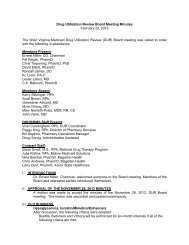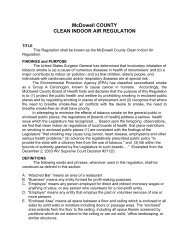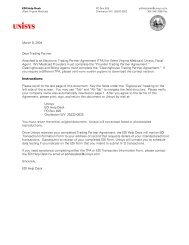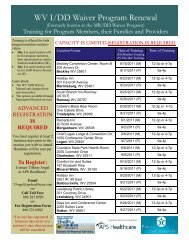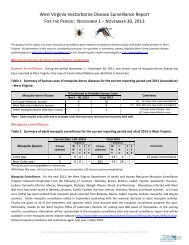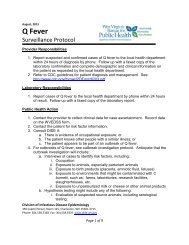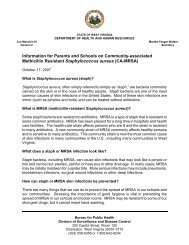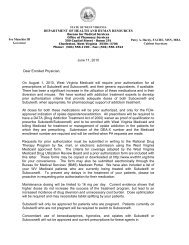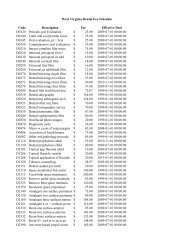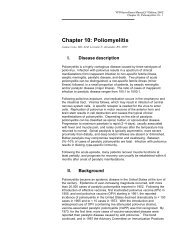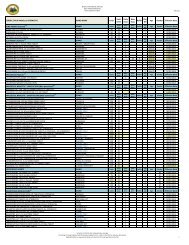WV Cyclospora Investigation Protocol - DHHR
WV Cyclospora Investigation Protocol - DHHR
WV Cyclospora Investigation Protocol - DHHR
You also want an ePaper? Increase the reach of your titles
YUMPU automatically turns print PDFs into web optimized ePapers that Google loves.
<strong>Cyclospora</strong> <strong>Investigation</strong> <strong>Protocol</strong>Provider Responsibilities1. Report <strong>Cyclospora</strong> cases to the local health department of the patient’s residencewithin 72 hours .2. Use the <strong>WV</strong>EDSS form and provide information indicated in the provider sections ofthe form (yellow section). This form is found at:HUhttp://www.wvidep.org/AZIndexofInfectiousDiseases/<strong>Cyclospora</strong>Infection/tabid/1574/Default.aspxU3. Report outbreaks of <strong>Cyclospora</strong> to the local health department immediately.Laboratory Responsibilities1. Report all positive <strong>Cyclospora</strong> results to the local health department in the patient’scounty of residence within 72 hours of result. Send or fax a copy of the laboratoryresult to the local health department in the county of residence of the case patient.2. Report outbreaks of <strong>Cyclospora</strong> immediately.Public Health Action1. Educate providers and the public about transmission and prevention of<strong>Cyclospora</strong>2. Educate providers and laboratories to report <strong>Cyclospora</strong> infections to the localhealth department in the patient’s county of residence within 72 hours ofdiagnosis.3. Conduct an appropriate investigation as follows:a. For sporadic cases: Complete the West Virginia Electronic DiseaseSurveillance System (<strong>WV</strong>EDSS) Foodborne Disease <strong>Investigation</strong> Form.Laboratory results should also be attached. Use of the <strong>WV</strong>EDSSFoodborne Disease <strong>Investigation</strong> Form will prompt the local healthdepartment to complete an appropriate investigation, to include: 1) acomplete food history; 2) history of exposure to fresh fruits andvegetables; 3) identification of high-risk persons or symptomaticindividuals for further investigation; and 4) identification of specificbehaviors that may be associated with <strong>Cyclospora</strong> infection. Use anincubation period of 2-14 days.b. For small outbreaks (two or more cases linked by person/place/time):Begin the epidemiological investigation as in 3a above. Consult theInfectious Disease Epidemiology Program (IDEP) at 1-800-423-1271c. For large outbreaks (five or more cases linked by person/place/time):West Virginia Department of Health and Human Resources Page 1January, 2009
Consult IDEP immediately at 1-800-423-1271.4. Identify other symptomatic persons and refer for laboratory testing, if appropriate.5. Persons with diarrhea should be excluded from school, work or daycare untilasymptomatic and educated about hand hygiene before their return.Disease Control ObjectivesReduce the risk of additional cases by identifying and investigating outbreaks at theearliest possible time so that control measures can be instituted rapidly.Disease Prevention ObjectivesReduce the incidence of <strong>Cyclospora</strong> by appropriate investigation of outbreaks andclusters to identify and remove any common source of disease.Disease Surveillance Objectives1. Determine the incidence of <strong>Cyclospora</strong> in West Virginia2. Identify demographic characteristics of persons with <strong>Cyclospora</strong>3. Identify risk characteristics of persons with <strong>Cyclospora</strong>.4. Identify outbreaks of <strong>Cyclospora</strong> at the earliest possible time.Public Health Significance<strong>Cyclospora</strong> occurs world-wide, but is common only in non-industrialized countries. Inendemic countries, incidence is seasonal, occurring more commonly in the late springand summer months.Outbreaks in the US and Canada have been associated with imported raspberries andsalad items from South America. A series of outbreaks in 1996 sickened 1465 personsin 20 states and 2 Canadian provinces. Ultimately, the illness was traced to importedraspberries grown in Guatemala. It was unknown how the raspberries becamecontaminated. Another multi-state outbreak occurred in 1997, also linked to raspberriesfrom Guatemala. Other outbreak investigations have implicated imported basil,mesclun lettuce and snow peas as vehicles.The life cycle of <strong>Cyclospora</strong> is unknown and it is not known if the protozoan can infectanimals other than humans. Public health plays a major role in furthering ourunderstanding of this pathogen.West Virginia Department of Health and Human Resources Page 2January, 2009
Clinical DescriptionSymptoms are characterized by watery diarrhea, nausea, abdominal cramping andbloating, anorexia, fatigue, and weight loss. Symptoms such as vomiting, low-gradefever and muscle and joint aches are seen in some individuals. Onset of illness occursabruptly in many cases, with symptoms lasting 10 to 20 days or longer. Symptoms maycome and go during that time. In patients with AIDS, symptoms may last for months.Asymptomatic infection can occur, especially in endemic areas, and prolongedasymptomatic shedding of oocysts can occur after recovery.Etiologic Agent<strong>Cyclospora</strong> cayetanensis is a sporulating coccidian protozoon that infects the uppersmall intestine.ReservoirThe reservoir is unknown; however, <strong>Cyclospora</strong> does not require a host other thanhumans to complete its life cycle. The host range is unknown.Mode of TransmissionTransmission is foodborne or waterborne, and occurs when drinking or swimming incontaminated water or eating contaminated fruits and vegetables.Incubation PeriodThe average incubation period is one week. Range is 2-14 days.Infectious PeriodPatients with cyclospora are unlikely to transmit infection to others because excretedoocysts require days to weeks to sporulate and become infectious.Outbreak RecognitionOutbreaks are usually recognized in association with an event where food was served.Where cyclosporiasis is suspected as an etiologic agent, public health staff shouldassure that appropriate testing is performed for <strong>Cyclospora</strong> at a reliable referencelaboratory and that detailed food histories are obtained. Since much is still unknownabout this pathogen, it is important to engage an experienced epidemiologist ininvestigating an outbreak of <strong>Cyclospora</strong>.West Virginia Department of Health and Human Resources Page 3January, 2009
Case Definition1998 Case DefinitionClinical descriptionAn illness of variable severity caused by the protozoan <strong>Cyclospora</strong> cayetanensis andcommonly characterized by watery diarrhea, loss of appetite, weight loss, abdominalbloating and cramping, increased flatus, nausea, fatigue, and low-grade fever. Vomitingalso may be noted. Relapses and asymptomatic infections can occur.Laboratory criteria for diagnosisLaboratory-confirmed cyclosporiasis shall be defined as the detection—in symptomaticor asymptomatic persons—of <strong>Cyclospora</strong>1. oocysts in stool by microscopic examination, or2. in intestinal fluid or small bowel biopsy specimens, or3. demonstration of sporulation, or4. DNA (by polymerase chain reaction) in stool, duodenal/jejunal aspirates or smallbowel biopsy specimens.Case classificationConfirmed, symptomatic: a laboratory-confirmed case associated with one of thesymptoms described aboveConfirmed, asymptomatic: a laboratory-confirmed case associated with none of theabove symptomsLaboratory DiagnosisMost laboratories do not test for <strong>Cyclospora</strong> without a specific request from thephysician. A single negative stool does not rule out cyclosporiasis, since oocysts canbe shed intermittently at low levels.<strong>Cyclospora</strong> can be identified in wet mounts under phase microscopy. Ultraviolet lightenhances detection because <strong>Cyclospora</strong> autofluoresce. Modified acid-fast stains andmodified safranin stains are also used to detect the organism. PCR methods haverecently been developed.Pseudo-outbreaks have been reported due to false-positive laboratory test results.Outbreaks with atypical clinical or other findings should be confirmed by testing at areference laboratory.TreatmentTrimethoprim-sulfamethoxazole is the drug of choice.West Virginia Department of Health and Human Resources Page 4January, 2009
Preventive InterventionsProduce should be washed before it is eaten. This may reduce but probably will noteliminate the risk of <strong>Cyclospora</strong> infection.Surveillance Indicators1. Proportion of investigations with complete demographic information.2. Proportion of outbreaks reported immediately upon recognition.3. Proportion of outbreaks with an identified source.References1. CDC. Outbreaks of <strong>Cyclospora</strong> cayetanensis infection – United States, 1996.MMWR, 1996; 45:549-551.2. CDC. Update: outbreaks of <strong>Cyclospora</strong> cayetanensis infection – United Statesand Canada, 1996. MMWR, 1996; 45:611-612.3. CDC. Outbreaks of pseudo-infection with <strong>Cyclospora</strong> and Cryptosporidium –Florida and New York City, 1995. MMWR, 199; 46:345-358.4. CDC. Outbreak of cyclosporiasis associated with snow peas – Pennsylvania,2004. MMWR, 2004; 53:876-878.5. Herwaldt BL, Ackers M and the <strong>Cyclospora</strong> Working Group. An outbreak in1996 of cyclosporiasis associated with imported raspberries. New Engl J Med,1997; 336:1548-56.6. Herwaldt BL, Beach MJ and the <strong>Cyclospora</strong> Working Group. The return of<strong>Cyclospora</strong> in 1997: another outbreak of cyclosporiasis in North Americaassociated with imported raspberries. Ann Intern Med, 199; 130: 210-220.7. Herwaldt B L. <strong>Cyclospora</strong> cayetanensis: a review, focusing on the outbreak ofcyclosporiasis in the 1990s. Clin Infect Dis, 2000. 31:1040-57.8. Marshall MM, Naumovitz D, Ortega Y, and Sterling CR. Waterborne protozoanpathogens. Clin Microbiol Rev, 1997; 10: 67-85.9. Nichols GL. Food-borne protozoa. Br Med Bull, 1999; 55:209-235.West Virginia Department of Health and Human Resources Page 5January, 2009





